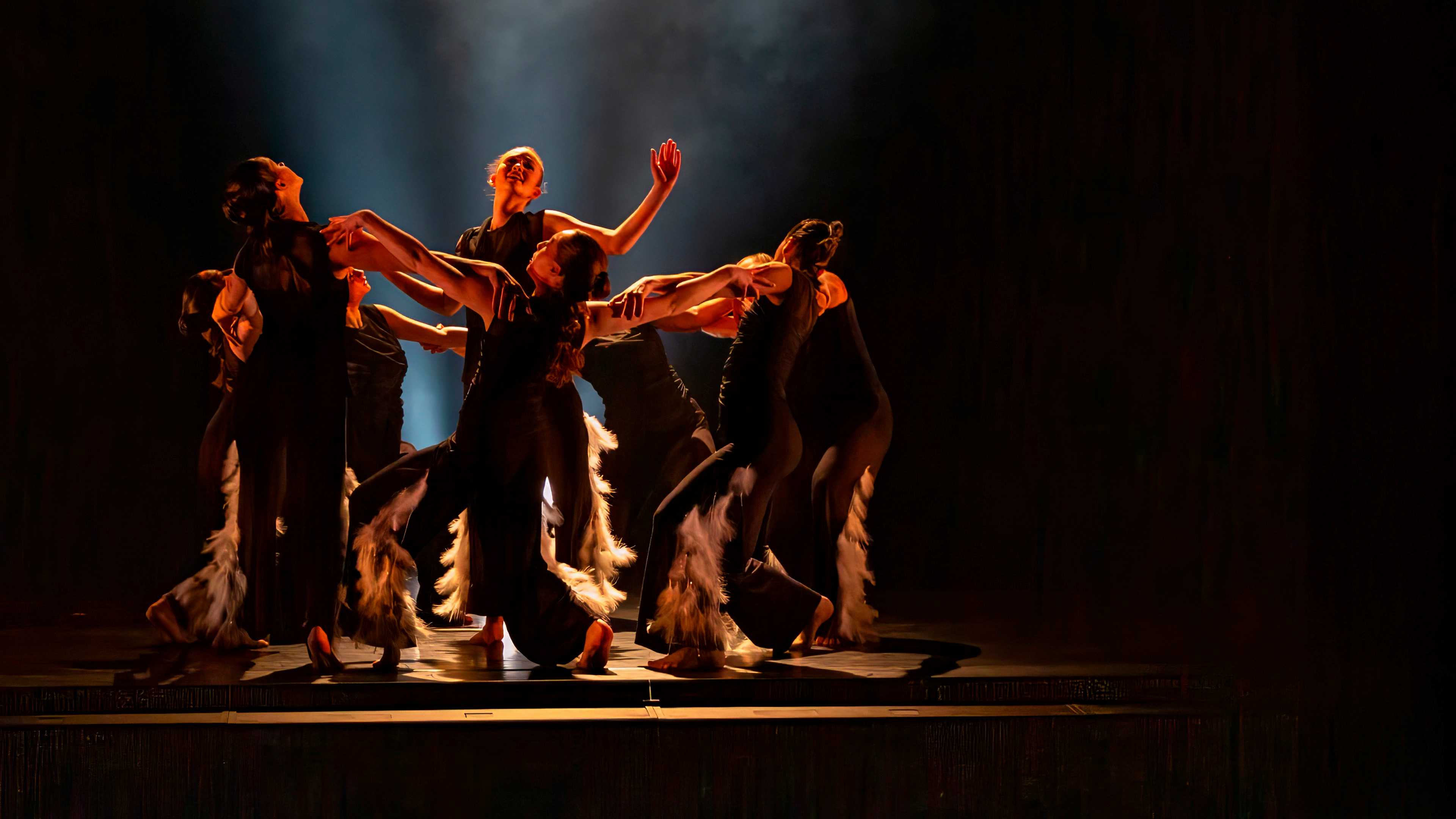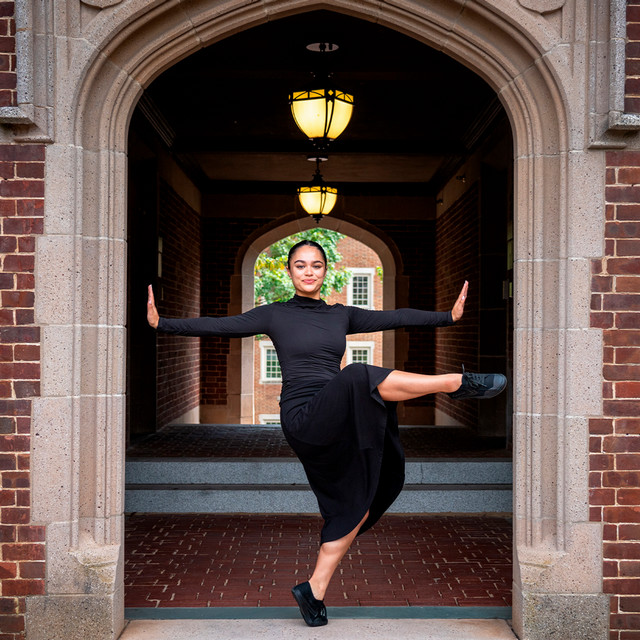How do you place a dancer in the spotlight?
For about 20 minutes in late February in UR’s Alice Jepson Theatre, the question was technical, not metaphorical. During rehearsal, dancer Karen Fleming, ’21, had just leapt into the air, bending her left knee and throwing her right leg back while in the air. (Fleming later said the move is best described as a “sauté developpé arabesque.”) But when she landed crouched on the floor, she was in darkness. A red circle of light meant to illuminate her shone on an empty spot several feet downstage.
Junior Keira Vogel called for a pause to adjust the spotlight. As stage manager, she was the hub of a student team that cued the lights, ran the sound, and changed the sets between pieces. In the darkness of the Alice Jepson Theatre, Vogel chatted with the lighting team through her headset as they isolated the moment of the jump on their extensive cue sheets.
Meanwhile Fleming, who dances professionally with the Ballet Theatre of Maryland, stood patiently on the stage where she once served as company captain. As a student, she had danced the piece she now rehearsed as a returning guest artist, its choreography and beats part of her muscle memory. After 10 or 15 minutes, she got into position to redo the jump.
“Where do you want me to land?” she asked Vogel.
“You be where you want to be,” Vogel replied. “I will move the dot to you.”
Getting the spotlight on a dancer was Vogel’s work of the moment. More generally, it is also the guiding ethos of the University Dancers, which celebrated its 40th season this year.
“We have amazing students,” said Anne Van Gelder, UR’s director of dance. She is in her 28th year working with University Dancers, the last 15 as the company’s artistic director. She has seen the company continually build on its strengths in the quality of dance, choreography, and production design. “I think this is related to our collaborative practices, the way we mentor student work, and ongoing interest from faculty and guest artists in giving students—both cast and crew—challenges to navigate within each work,” she said.
As part of the milestone anniversary, the theatre and dance department commissioned a first in the company’s long history. A six-minute film called bolero showcases dancers in locations throughout campus. Van Gelder called making the film “a project like no other.” The planning process began more than a year before collaborators Robin Dekkers and Ben Estabrook came to campus for a week in mid-September to work with the dancers and do the filming. bolero premiered at the concert. (You can watch it below.)
“I am very proud of the work we all achieved together,” Van Gelder said of the project. “I am especially proud of the students—their collaborative spirit, their sustained energy, and excellence. We now have a dance film that can be used for years to represent opportunities in dance at Richmond.”



“I feel like I’ve gotten an unexpected second leg of my dance journey, and I’m really grateful.”
bolero opens with a dancer running along campus walkways and bridges, eventually joining up with the company as it performs in front of Jepson Hall, on Westhampton Green, and at other locations. That first dancer is senior Maggie Crowe, the 2024-25 company captain. As a high school student, Crowe was enrolled in one of New Jersey’s top preprofessional dance programs and had classmates who pursued dance as a post-secondary professional path. Crowe chose a different route, double majoring in dance and American studies, with plans to pursue consulting after graduation. Law school might be in her future, too.
“When I got here, I was just so pleasantly surprised,” she said. “It surpassed every one of my expectations—the level of dance training, the production value for concerts. I feel like I’ve gotten an unexpected second leg of my dance journey, and I’m really grateful.”
Crowe’s many roles in the 40th anniversary concert illustrate the breadth of opportunities for dancers at Richmond. After bolero featuring her premiered to kick off the concert, she danced in five of the eight live pieces. She was choreographer for a sixth piece, which meant also doing its costume design and music editing. In the final piece, she had two extra roles in addition to dancer: assistant choreographer and rehearsal assistant.
This diversity of experiences has always been part of University Dancers. The company got its start in 1985 under founder Myra Daleng. When UR hired her as a part-time dance instructor in 1982, dance faculty and courses were in Westhampton’s health and physical education department. Daleng stewarded its shift to an institutional home in the arts and created the University Dancers to elevate the artistry and opportunities for students interested in dance. Its showcase piece then, as today, was the annual spring concert.
Cheryl Behrens Policastro, B’89, was an original member of the company and a three-year company captain. She came to Richmond intending to major in either business or journalism and chose business. Today, she combines the interests that drove both potential majors as senior vice president of strategic marketing for Market Performance Group in New York City. Growing up, she took dance lessons and performed in high school musicals—“My contribution was always dance because, sadly, I can’t sing,” she said—but she had no expectation of continuing this interest at Richmond.

“I am confident that we have demonstrated that studying and participating in the arts matters.”
“I got lucky,” Policastro said. “My freshman year was the year the company was formed. … I did have a sense that we were the first, and it was exciting to recruit others and figure out how it was all going to work.”
In Daleng, she found an enthusiastic champion for elevating dance. “Myra was really genius, how she pulled it all together. It was very scrappy, and the university was very supportive in terms of tech and rehearsal space.” That first rehearsal space was the dining hall in North Court, now Perkinson Recital Hall. They also had access to space in the Robins Center. The Modlin Center, where the company rehearses and performs today, had not yet been built.
According to a 1986 article in The Collegian, Policastro tore it up at the opening concert dancing to Sheila E.’s “The Glamourous Life.” Her performance “caus[ed] the audience to applaud long and loud as she finished,” a student reporter wrote.
Policastro’s most lasting memory is something Crowe, this year’s company captain, and her fellow seniors, surely recognize.
“Being in the green room is one of the best experiences ever,” Policastro said. “It’s a time when everyone is supporting one another, and you really feel like you’ve got this big family around you wanting you to do your best. The feeling trumps being on the stage by a long shot. The joy of that and the feeling of fulfillment is something that will never leave me.”



The piece Crowe choreographed for the 40th anniversary concert captured that same supportive feeling. She described it as “a swan song” for herself and her fellow seniors. Called “Songs Of,” it featured her four classmates individually in each of four sections danced to songs by U2, a favorite of Crowe’s parents. Her father used the band’s song “Beautiful Day” as the soundtrack to a family video capturing a key moment in their lives. It shows her parents meeting her for the first time as a baby in an orphanage in China during the process of adopting her. “My whole plan is to make my parents cry,” Crowe said during tech week, only half joking.
“Beautiful Day” is one of the songs featured in “Songs Of.” In the final section, the version of “40” recorded live at U2’s legendary 1983 Red Rocks Amphitheatre show in Colorado plays. As the song crescendos and then fades, the Red Rocks audience carries on singing the chorus “How long to sing this song?” over and over. Crowe choreographed a moment, with this audio playing in the Alice Jepson Theatre, for each of the seniors to step to the front of center stage, take a bow, and exit. The last of them was Hannah Zaheer, Crowe’s roommate of three years and one of her closest friends. Crowe also danced in a piece choreographed by Zaheer, “Sonder.”
“It actually makes me emotional every time, even when I think about it and in rehearsal—even when she first gave us that choreography and the first time we did it in rehearsal through our first run-through on stage,” Zaheer said a few days before opening night. “I’ve choked up a few times. It’s also very emotional watching it, even though I’m actively dancing—seeing each of the seniors bow and leave the stage—because all five of us are very close.”
It was a moment that encapsulated the entire concert and the company at its 40th anniversary: a legacy of dancers, mentors, artists, and dear friends putting one another in the spotlight. It is also preparing them for what comes next, whatever that may be.
“I’ve choked up a few times. It’s also very emotional watching it, even though I’m actively dancing.”
Fleming, the alumna jumping the sauté developpé arabesque into the darkness during rehearsal, found the spotlight on every landing during the performances. Back home in Maryland, she is building a career in dance. Policastro, one of the company’s original members, built her career in marketing in New York City. Crowe plans on consulting. Several other members of the current company major in the sciences and health studies. Others major in business, elementary education, leadership studies, and more. One has a concentration in neuroscience via the psychology department. The skills they are building by being part of University Dancers will carry them forward wherever they go.
“I am confident that we have demonstrated that studying and participating in the arts matters,” Van Gelder said. “In addition to choreography, they learn adaptability, resilience, collaboration, and how to overcome most any challenge. Countless former students have let me know that their work in UD—learning from a variety of choreographers, creating works of their own, and adapting to a diversity of dance styles—has prepared them for most any career.”


